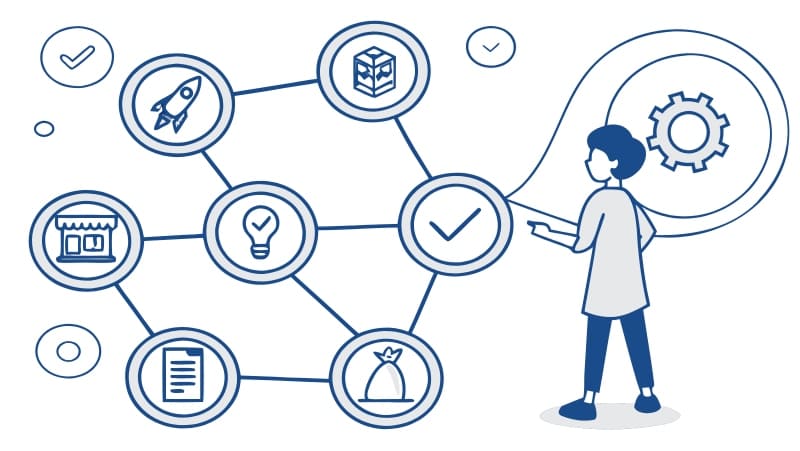What is Product Development Strategy?
I’ve seen countless businesses waste resources on products nobody wants. Without a clear development strategy, you’re essentially throwing money at the wall and hoping something sticks.
A product development strategy is your roadmap for creating products that customers actually need. It combines market research, resource planning, and systematic execution to turn ideas into profitable solutions that solve real problems.

After 15 years in product development and manufacturing, I’ve learned that success isn’t about having the best idea. It’s about having the best plan to execute that idea. Let me share what I’ve discovered about building strategies that actually work.
What is Meant by Product Development Strategy?
Have you ever wondered why some products become overnight successes while others disappear without a trace? The answer usually lies in the strategy behind them.
Product development strategy is a comprehensive plan that guides how you research, design, test, and launch products. It aligns your team’s efforts with market needs while managing risks and resources effectively.

I remember working with a client who had an amazing product idea but no clear strategy. They jumped straight into manufacturing without proper market validation. Six months later, they had 10,000 units sitting in a warehouse because nobody wanted to buy them.
A solid strategy prevents this by addressing several key areas:
Market Intelligence
- Customer pain points and preferences
- Competitor analysis and positioning
- Industry trends and future opportunities
Resource Management
| Resource Type | Allocation Method | Success Metrics |
|---|---|---|
| Budget | Phase-based releases | ROI per milestone |
| Personnel | Cross-functional teams | Delivery timelines |
| Technology | Scalable platforms | Quality standards |
Risk Mitigation
- Technical feasibility assessments
- Market acceptance validation
- Supply chain reliability checks
The strategy serves as your north star, keeping everyone focused on what matters most: creating value for customers while building a sustainable business.
What is an Example of a Development Strategy?
Want to see how this works in practice? Let me tell you about one of my most successful client projects that perfectly illustrates effective strategy implementation.
A technology-pull strategy focuses on leveraging existing capabilities to create new market opportunities. Companies like 3M excel at this by finding multiple applications for their core technologies across different industries.

I worked with an electronics company that had developed advanced battery technology for industrial applications. Instead of limiting themselves to one market, we created a strategy to adapt this technology for consumer devices, electric vehicles, and renewable energy storage.
Here’s how different strategy types work in practice:
Market-Pull Strategy
- Start with customer needs
- Develop solutions backward
- Example: Uber identifying transportation pain points
Technology-Push Strategy
- Begin with technical capabilities
- Find market applications
- Example: Gore-Tex expanding from industrial to consumer products
Platform Strategy
- Build core systems for multiple products
- Leverage economies of scale
- Example: Google’s Android across devices
Hybrid Approach
| Phase | Focus | Key Activities |
|---|---|---|
| Research | Market needs | Customer interviews, surveys |
| Ideation | Technology match | Feasibility studies, prototyping |
| Development | Integration | Design, testing, refinement |
| Launch | Market fit | Pilot programs, feedback loops |
The key insight I’ve learned is that successful strategies often combine multiple approaches. You might start with a market need but pivot based on technical constraints, or begin with a technology breakthrough and discover unexpected market opportunities.
What are the 7 Steps to Develop a Product Strategy?
Creating a winning strategy doesn’t happen by accident. After developing hundreds of products, I’ve refined a systematic approach that consistently delivers results.
The seven-step framework provides a structured path from initial concept to market success. Each step builds on the previous one, creating momentum while reducing risks through validation and iteration.

I’ve used this framework with clients ranging from startups to Fortune 500 companies. The principles remain the same regardless of company size or industry.
Step 1: Market Discovery Start by understanding your market deeply. I spend at least 30% of project time on research because everything else depends on getting this right. Talk to potential customers, analyze competitors, and identify trends that create opportunities.
Step 2: Problem Definition Define the specific problem you’re solving. I’ve seen too many products fail because they tried to solve everything for everyone. Focus on one core problem that enough people care about to pay for a solution.
Step 3: Solution Design
| Design Element | Key Questions | Validation Method |
|---|---|---|
| Core Features | What’s essential vs. nice-to-have? | User testing sessions |
| User Experience | How will customers interact? | Prototype feedback |
| Technical Specs | What’s feasible within budget? | Engineering review |
Step 4: Business Model Creation Determine how you’ll make money. This includes pricing strategy, distribution channels, and revenue projections. I always create multiple scenarios to understand different paths to profitability.
Step 5: Development Planning Create detailed timelines and resource requirements. Break the project into phases with clear milestones and success criteria. This helps manage stakeholder expectations and allows for course corrections.
Step 6: Validation and Testing Build prototypes and test with real users. I recommend starting with simple mockups before investing in expensive prototypes. Get feedback early and often to avoid costly mistakes later.
Step 7: Launch Preparation Plan your go-to-market strategy including marketing campaigns, sales training, and customer support systems. Many great products fail because companies don’t prepare adequately for launch.
The beauty of this framework is its flexibility. You can adapt it for different industries, company sizes, and product types while maintaining the systematic approach that drives success.
Conclusion
A well-crafted product development strategy transforms ideas into market winners by systematically addressing customer needs, managing resources, and mitigating risks through proven frameworks.


